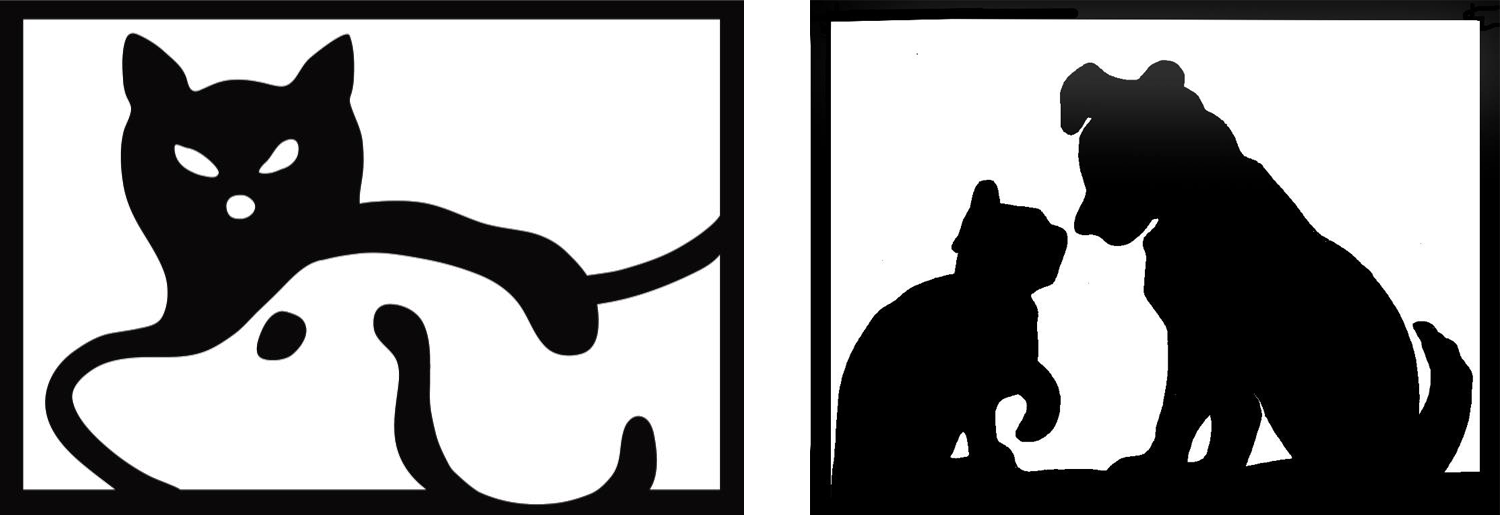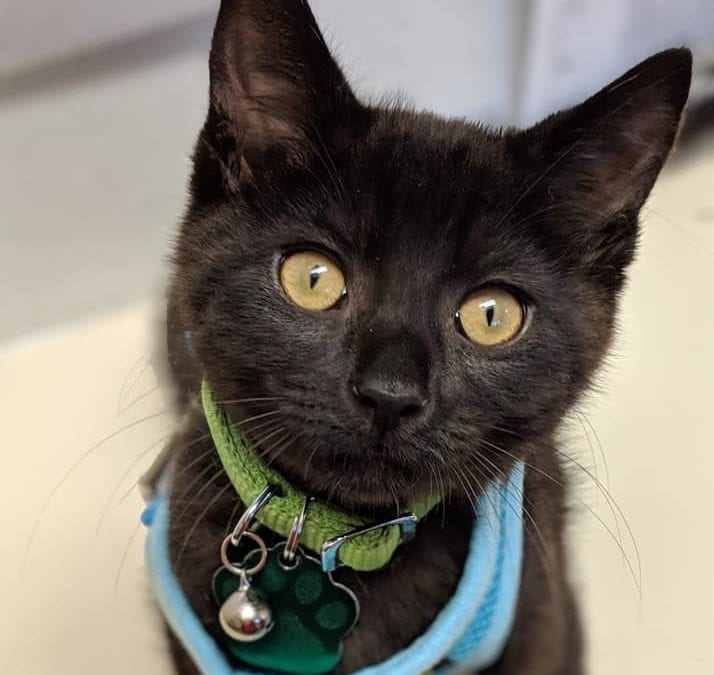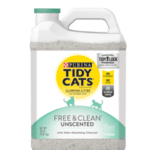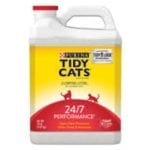The fifteen ways that being a veterinarian changed the way I’m raising my kittens
It had been almost 20 years since my cat, Mickey, was a baby. I was still in undergrad when I got him so we both had a lot of growing up to do together. Before Mickey, the last time I had a kitten of my own I was only 4.
Needless to say, a lot of my parenting style and ability have changed over the decades and becoming a vet has done the most to change my perspective on a cat’s formative years. Here are fifteen things I did different with Raven and Poe than I did with my past kittens:
1.Have a buddy. I have never owned more than one pet at a time so the experience of being double teamed by these two was a new one. Despite the way they both jump on me at once sometimes, I’m overwhelmingly glad that I got both of them. Not only do they love each other and cuddle almost any time they are resting, they also have someone to “be a cat with” which means they take out their cat appropriate kitten energy running around biting and wrestling with each other instead of my ankles.
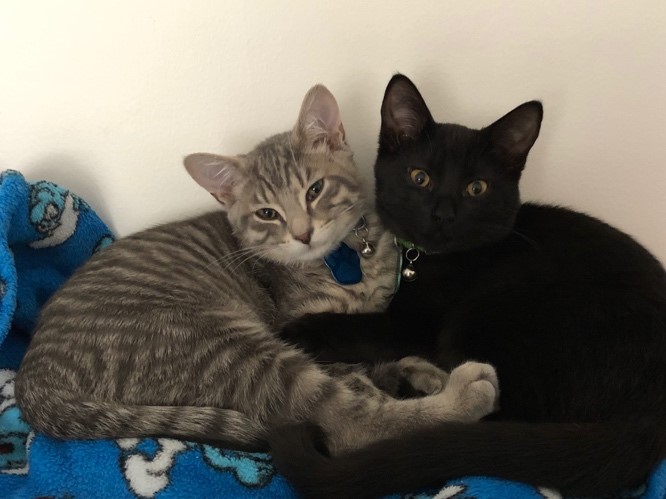
2. Respect their relationship. The man who raised the boys’ parents told me that Raven and Poe loved each other and were attached at the hip. He was really right; they are both surprisingly loving to each other but by their own choice. Yes, it is a little sad for me when they choose to snuggle each other instead of me but I’m happy they love each other so much. As a doctor I’ve often seen people introduce two cats together that were of different personality types and energy levels. Often this results in two cats that hover just barely above or below the line of coexistence rather than friendship.
3. Consider their perspective is different. I’ve noticed that many humans have a tendency to think that animals have similar motivations and logic to people. They assume that animals see the world in much the same way that we do. For example, a common thing that I hear from owners is that their pet was abused by a man in a baseball hat even though putting on and taking off the hat right in front of the pet will often result in a negative reaction. I’ve seen animals react similarly to 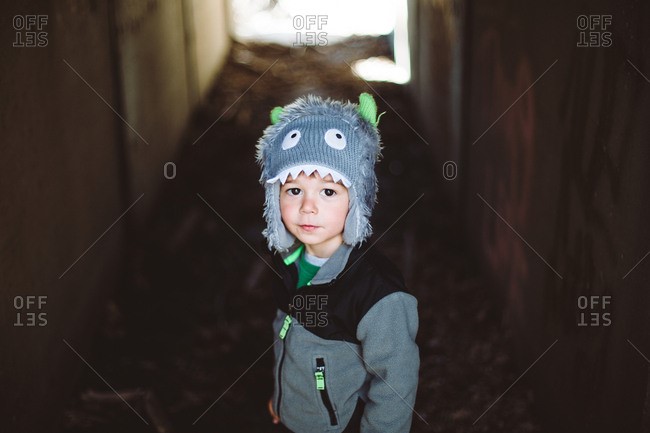 people with pens in their mouth or floppy hats. Its entirely possible that even though we recognize people by their facial features, animals may recognize us by different criteria like eyebrows or facial shape. Therefore, I’ve tried to teach Raven and Poe that humans come in many strange configurations by wearing hats, glasses, gloves, etc. around them during their socialization period.
people with pens in their mouth or floppy hats. Its entirely possible that even though we recognize people by their facial features, animals may recognize us by different criteria like eyebrows or facial shape. Therefore, I’ve tried to teach Raven and Poe that humans come in many strange configurations by wearing hats, glasses, gloves, etc. around them during their socialization period.
4. Consider their motivations. Now that Raven it getting in his adult hair, its difficult to see that he is just a darker, but virtually identical version, of Poe. That is where the similarity ends, however. Raven is very slow to purr but will cuddle with you for hours if you have the time. Poe on the other hand will purr very easily but gets annoyed with cuddling after only a few minutes. Another major difference is in the way they play. Both cats fetch their little bug toys for me daily. Strangely, even though Poe was the first one to master the skill, after only a few days of fetching it seemed like he “forgot” how to do it. Raven, on the other hand, only seemed to get better and better. Then I considered the motivational factor. What I learned is that Poe is a great fetcher if every time he brings you his toy you say what a good cat he is in an excited voice then spend a few minutes petting him while he purrs. When I tried a similar approach with Raven, however, he became impatient and danced around as if to say “Just throw it already!” Poe’s “forgetting” his fetching skills was completely resolved when I stopped assuming his motivation for fetching, like Raven’s, was simply the joy of playing!
5. Socialization. My parent’s cats were well socialized to people but would run and hide every time there was a noise as simple as the phone ringing. I wanted the boys to be able to face life without fear so during their primary socialization period, which ends by about 9 weeks in most cats, I brought them around dozens of people as well as cat friendly dogs and a variety of loud noises. The key was that these interactions had to be calm and happy. I asked the nice people I work with to pick up and cuddle the cats as well as feed them their food and engage in play behaviors. The dogs that they met all had cats of their own at home and good manners. As a result, the other day while I was vacuuming, both boys ran up to it to see what the really loud noise was! Raven even happily sits next to me while I pop the large packing air cells that serve as protective packaging.
6. Kitty Litter. I once had a client who started her cat on Tops Friendly Market house brand kitty litter as a kitten. She bought the brand religiously but in the mid 2000s the Tops chain pulled out of our regional market. After her regular kitty litter brand was no longer available her cat started urinating out of the box. In response, the owner had tried dozens of different brands of kitty litter but her cat would often refuse to use her litterbox. Cats are creatures of habit and after a decade of one type of litter everything else seemed strange to her. Because of this, I have introduced several kinds of scoopable litter to my kittens and they clearly have a preference for the very soft sandy kind. In fact, when I was using the “low tracking” kind, even though both of them would urinate in the main litterbox, they both stopped pooping in the main box altogether and instead would make a special trip to the box in the basement with a different kind of litter in it! I assume this had to do with how the courser litter felt on their little feet when they engaged in the deeper and longer digging that usually happens around poops.
7. Litterboxes. To prevent a lot of litterbox problems, always have more boxes than the number of cats in the house and make sure that they are located in such a way that if one cat guards one of the boxes, the other cat can sneak around and access a different box in secret. The other thing I did was reward the cats with treats whenever they used the litterbox in front of me. I know it sounds strange but about half of the health problems we see in cats revolve around the litterbox. Knowing about how much and how often your specific cat urinates and defecates is helpful in early detection of problems.
8. Preventatives and parasite control. Back when I was still on my veterinary externship, the first case I ever saw by myself was a vomiting cat. It turned out that the cat was much sicker than simple vomiting and her x-rays showed an unusual blood vessel pattern in her lungs. After a few more tests I discovered that her vomiting was one of the many and varied manifestations of feline heartworm disease. That cat was lucky, her owners brought her to the cardiologist and surgeon, had the worm surgically removed, and she survived. I’ve since seen several other cats who tested positive for heartworms and either died suddenly after going into organ failure or initially stabilized well but then died before the owner was able to have the worm surgically removed at the specialist. In addition to that, the boys sleep in bed with me. I never want to wake up to a tapeworm segment inching along my sheets so I give the boys their Revolution every month like clockwork!
9. Collars and Clothing.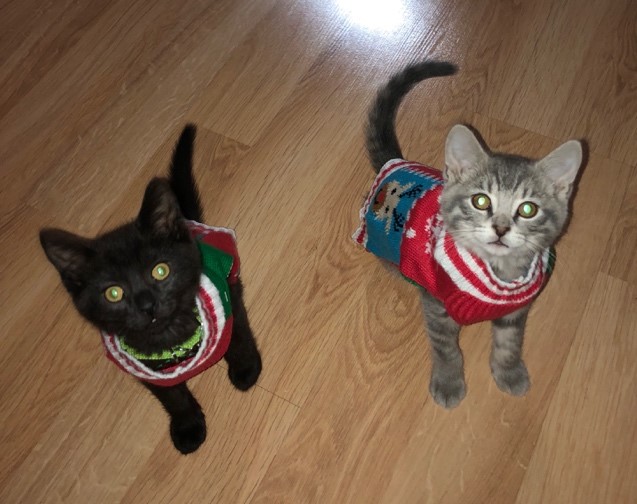 One of our greatest joys with Mickey was taking him places with us like the back yard or the drive in movies. In order to keep him safe, however, we always had him on a leash and harness. Putting on the harness also signaled to him it was an ok time to go outside and so he wasn’t one to try to sneak out when I wasn’t looking. I started putting harnesses, sweaters, and collars on the kittens the first day I got them at six weeks old. Nothing fit well because they were so tiny but I put them on several times a day nevertheless. Now both Raven and Poe are used to the idea of clothing and walk around nonchalantly while wearing them.
One of our greatest joys with Mickey was taking him places with us like the back yard or the drive in movies. In order to keep him safe, however, we always had him on a leash and harness. Putting on the harness also signaled to him it was an ok time to go outside and so he wasn’t one to try to sneak out when I wasn’t looking. I started putting harnesses, sweaters, and collars on the kittens the first day I got them at six weeks old. Nothing fit well because they were so tiny but I put them on several times a day nevertheless. Now both Raven and Poe are used to the idea of clothing and walk around nonchalantly while wearing them.
10. Foods. Well after Mickey was out of his socialization period I learned that cats are very shape and texture specific. For me this was a big problem because he would only eat dry cat food or canned cat food or the broccoli that my father-in-law introduced to him. As a result, when I needed to give him pills or bribe him I could only dry pill him then follow up with several pieces of dry cat food. The system worked well for us but mostly because Mickey ONLY got dry food as a treat and because I am skillful enough at pilling cats that I could quickly get one into the back of his mouth. With Poe and Raven I made sure to feed them a variety of different food types and textures from different consistencies of wet canned food all the way up to roasting them a duck to be used for treats. As a result, when I need to bribe these two into cooperating, they are more than happy to oblige.
11. Cat ID. There is nothing sadder than finding a pet with a collar but no ID tag or a pet whose microchip has only been registered to the breeder or shelter. Clearly the pet belongs to the person who put the collar on them or took them home from the shelter but there is usually no way of figuring out who that owner is. Both cats wear collars and ID tags at all times. I also recently purchased a round tag for Raven and a paw shaped one for Poe so I can tell the two apart in the dark.
12. Manners. Some manners are harder to learn than others. For Poe sitting quietly and waiting patiently has been a struggle. Nevertheless, because we do it every time I feed him or give him a treat, Poe knows that he has to sit. Prior to that Poe would jump at me and scream while I prepared his canned food and water. Even though it was very cute to hear his indignant, demanding, squeaky little seven-week-old meows, I knew the novelty would quickly fade. Now he usually sits next to my feet while I prepare his food, still anxious but holding it together. Raven usually sits right next to his feeding mat and waits for me to bring the bowls over to their usual location.
13. 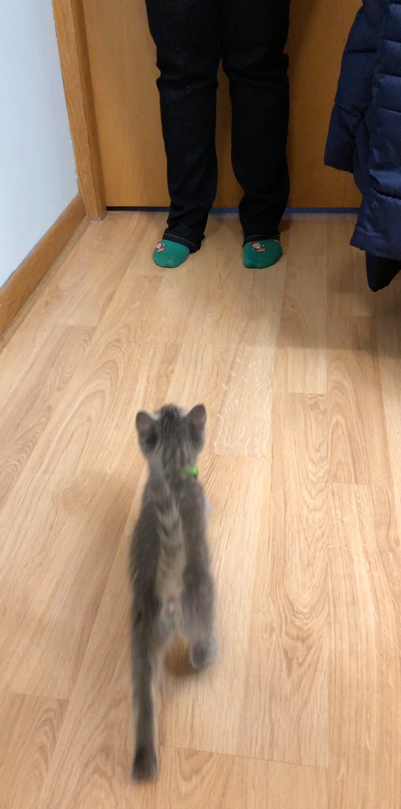 Coming when called. When the boys were babies, I used a tiny little cocktail fork and demitasse spoon to feed them part of their meals. I would load up the spoon then walk away from the kittens and call them each by name. When they came over to me they would be rewarded with food. I still call them from other parts of the house whenever they are getting a special treat and, although Poe is quicker to run up than Raven, they both come when called. This has come in hand for getting them to come out of awkward places like behind the dryer. I have also used this trick to get the boys away from the door when my husband signs for packages from the postman.
Coming when called. When the boys were babies, I used a tiny little cocktail fork and demitasse spoon to feed them part of their meals. I would load up the spoon then walk away from the kittens and call them each by name. When they came over to me they would be rewarded with food. I still call them from other parts of the house whenever they are getting a special treat and, although Poe is quicker to run up than Raven, they both come when called. This has come in hand for getting them to come out of awkward places like behind the dryer. I have also used this trick to get the boys away from the door when my husband signs for packages from the postman.
14. Feeding. 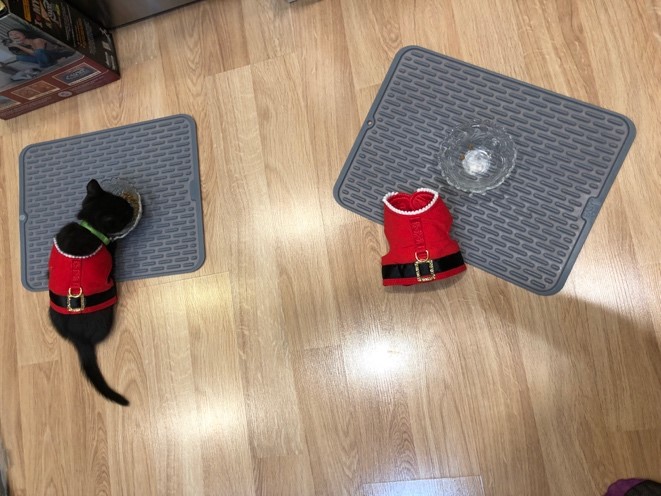 Even though Poe and Raven are twins they have two different metabolisms. Some of this is because Raven is fractionally larger but some of it has to do with their body types and energy level. Their dad was a larger more solid cat, their mom was petite and delicate. So far, although he is a tiny bit shorter, Poe takes after his father’s body type. His energy level is also lower than Raven’s. Through both body condition scoring them and also regularly weighing them, I have discovered that Poe simply can’t eat as much as Raven and stay fit. Because of this I have invested in some lower calorie kitten food for Poe and, when I feed them the same foods, I always feed Poe less.
Even though Poe and Raven are twins they have two different metabolisms. Some of this is because Raven is fractionally larger but some of it has to do with their body types and energy level. Their dad was a larger more solid cat, their mom was petite and delicate. So far, although he is a tiny bit shorter, Poe takes after his father’s body type. His energy level is also lower than Raven’s. Through both body condition scoring them and also regularly weighing them, I have discovered that Poe simply can’t eat as much as Raven and stay fit. Because of this I have invested in some lower calorie kitten food for Poe and, when I feed them the same foods, I always feed Poe less.
15. Vaccinations. At work I regularly see stray and unvaccinated but owned cats. These cats generally suffer severely when they are exposed to the viruses for which we have vaccines. There is also a large white cat that hangs around my house sometimes. I worry that eventually the boys could have some “through the screen” contact him. Because, like my heartworm patients, I have seen animals die from completely preventable diseases, I make sure the boys are up to date on vaccines for the diseases for which they are at risk.
For additional information please visit: Drsophiayin.com
Angela Albers, DVM
Stow Kent Animal Hospital
